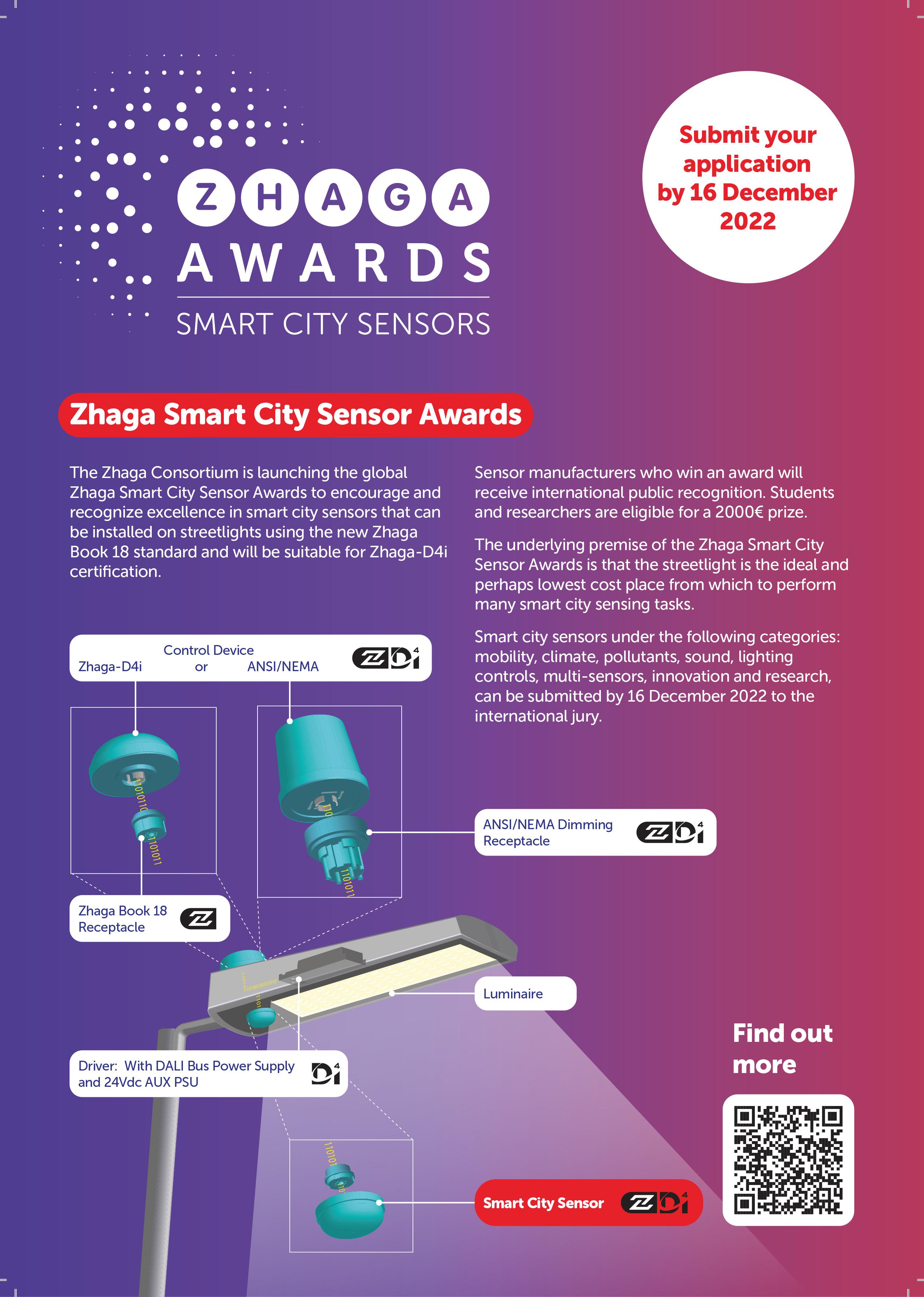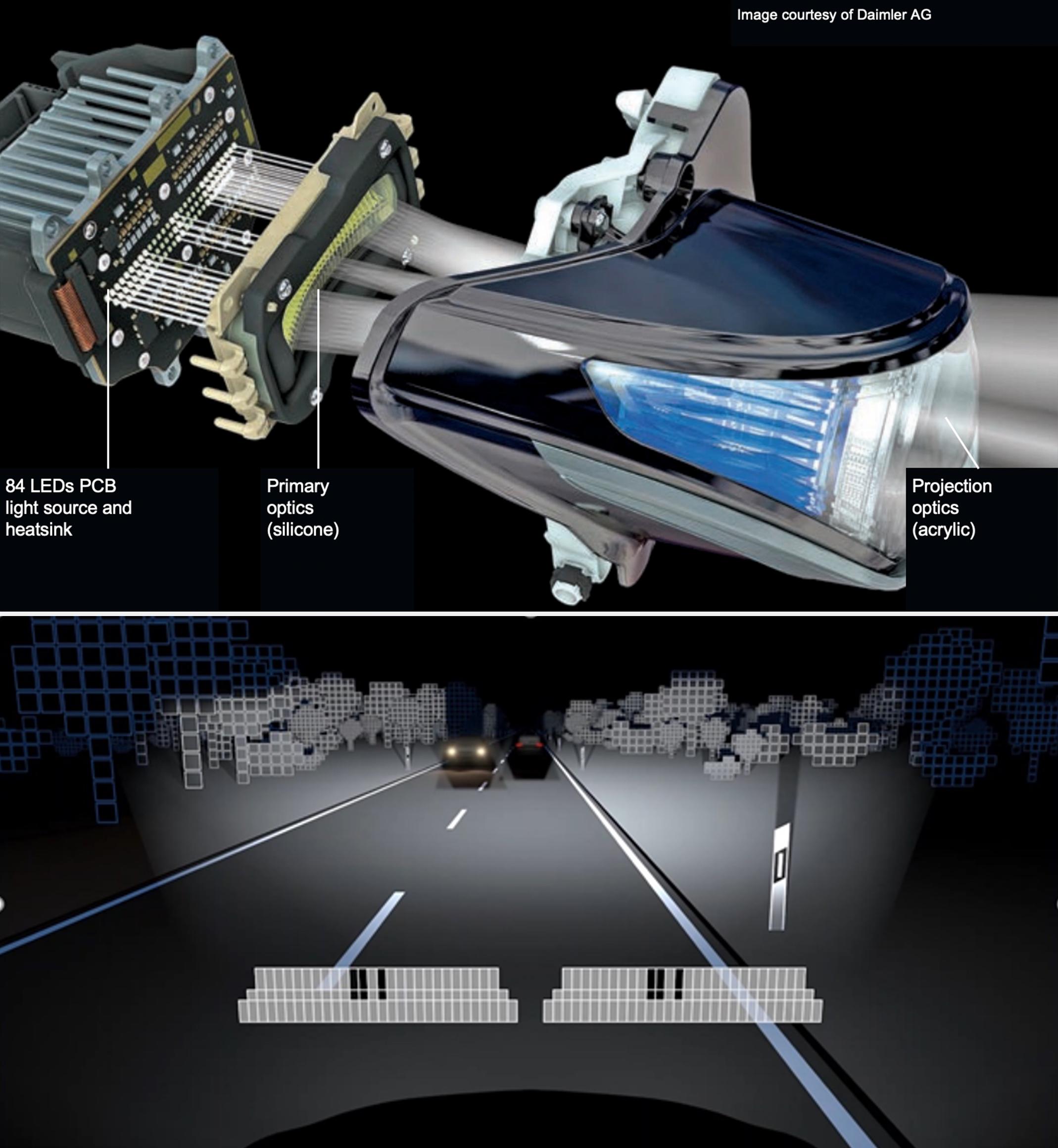
23 minute read
Adaptive-Driving-Beam Headlights A Collaborative Approach to Efficient Manufacturing of Complex Shapes Optical LSR Parts
Martijn BEUKEMA1, François DE BUYL2,email, Hannes RIEGER3 , Jake STEINBRECHER4, Kevin VAN TIGGELEN5; Dow and ELMET
The use of Adaptive-Driving-Beam (ADB) headlamps in Europe and Asia, together with the recent announcement by the U.S. Department of Transportation’s National Highway Traffic Safety Administration (NHTSA) to allow ADB on new vehicles, will contribute to reducing the number of roadway collisions and an increase in automotive safety for everyone. Injection molding technology for optically transparent Liquid-Silicone-Rubber (LSR), the proper selection of material, molding parameters and automation design are strategic elements to successful and efficient industrial production of silicone primary optics used in ADB headlights. To enable ADB silicone lens production for headlamp manufacturers, across vehicle segmentation, Dow and ELMET have joined efforts. This collaboration aimed to validate the new optical SILASTIC™ MS-5002 Moldable Silicone from Dow using ELMET’s world class injection molding equipment, with the common objective to manufacture complex optical LSR parts, ultimately leading to more efficient light extraction from the LED and projection by the headlamps on the road.
1,2,5 Technical Service & Development (TS&D) Scientists in the Mobility & Transportation department with Dow Silicones Belgium, Industrial Zone C, B-7180 Seneffe. 3 Head of R&D with ELMET Elastomere Produktions- und Dienstleistungs-GmbH, Tulpenstraße 21, A-4064 Oftering. 4 TS&D Scientist in the Mobility & Transportation department with Dow Silicones Corporation, 2200 W. Salzburg Rd, MI48686 Midland. email francois.debuyl@dow.com
Introduction
SILASTIC™ MS-5002 Moldable Silicone from Dow, an optical moldable silicone introduced to the market in the early 2010’s, enables advanced Adaptive-Driving-Beam (ADB) headlamp lighting systems in a continuously broadening selection of cars of all classes since 2014 [2,3]. The use of ADB headlamps – already embraced in Europe and Asia, helps reduce the number of roadway collisions and increases automotive safety [4,5].
The principle of ADB headlights with silicone primary optics is predominantly used in the market to improve system efficiency. The technology is based on dynamic and addressable control of multiple LED light sources. Each LED is aligned to a single lightguide of a multiple-lightguide silicone primary optic that projects the light beams on the road through a front secondary optic in the light engine (Figure 1) [6]. ADB headlight technology enables long-range visibility without causing glare, discomfort and distraction, improving safe driving at night.
To expand product offerings and improve the productivity of ADB silicone optic designs, SILASTIC™ MS-5002 Moldable Optical Silicone is now offered as Dow’s new benchmark standard of optical LiquidSilicone-Rubber (LSR). Specifically designed for the ADB market. MS-5002 provides a unique set of improved and optimized cure kinetics, mechanical, and optical properties. Enabling optic designs required for ADB concepts to be reliably molded and demolded, offering robust molding process windows for large volume, fully automated mass production. Initial confirmation of this improvement was completed using a Dow, in-house, 12lightguide matrix molding tool. As well as a dedicated light-engine and photometry characterization setup developed to correlate the light intensity from every individual light guide to the degree of mold fouling building-up on the inside surfaces of the mold inserts, cycle after cycle [7,8].
Dow and ELMET have pursued a collaborative journey in the design of a turnkey solution. Confirming that SILASTIC™ MS5002 from Dow and ELMET SMARTmix TOP 7000 Pro LSR dosing technology contribute to a step-change in innovation for injection molding of silicone lightguide lenses used in automotive lighting. Proving that combined technical expertise in silicone chemistry, liquid injection molding processing and optics engineering bring value across the value chain of automotive LED headlamps.
The two optical LSRs compared in this injection molding study were SILASTIC™ MS-1002 and MS-5002 Moldable Silicones. While MS-1002 is already qualified at a majority of Tier 1 headlamp manufacturers for OEMs, MS-5002 has been developed to address specific challenges in productivity encountered by injection molders in a growing market [9]. The launch of MS-5002 is aligned to Dow’s roadmap of continuous innovation of optical grade silicone materials in the field of automotive LED lighting applications [7,8].
Mold fouling consists of an accumulation of nano to micro layers of silicone building-up onto the highly polished optical surfaces of the steel mold insert. This fouling build-up causes deterioration of the optical surface quality of the lightguides as the number of injection molding cycles increases. Prior work internal to Dow using 12-lightguide optics have shown a light intensity decay
of 10%, due to fouling, that occurs after ≈ 1,800-2,500 shots with MS-1002 versus ≈ 7,000-10,000 shots for MS-5002. This corresponds to a ≈ 4 to 5 times productivity improvement with MS-5002 [7,8,10].
The underlying mechanism by which mold fouling causes light loss from individual lightguides of the lens is illustrated in Figure 2. As the optical surface of the lightguide deteriorates due to fouling deposits, the internal reflection condition is disrupted and light is coupled out of the lightguide resulting in an intensity drop of the light emerging from the end of the lightguide, and in the end, a reduction of the amount of light in front of the car illuminating the road.
Moldable Optical Silicone
The use of optical grade LSR for designing and manufacturing of optical parts in LED lighting fixtures and modules is now well established for more than 10 years [11,12]. The benefits of optical silicone versus other traditional optical materials used in photonics applications (e.g., epoxy, acrylics, polycarbonate, glass, and quartz) are numerous. Such as: photo-thermal stability [13], high luminous transmittance, low chromatic dispersion (Abbe number ≈ 52), stability against sunlight and UV radiation, ease of processing with low pressure liquid injection molding, excellent surface feature replication and easily molded into complex optical shapes - including parts with negative draft angles. When multiple stress factors apply for a given LED lighting application, then the choice of silicone for designing the optical component makes sense. With trends in LED lighting fixtures designs evolving to higher power LED’s and miniaturization, the following characteristics are enhanced: (i) increasing of optical pitch density, (ii) reduction of backlight losses, and (iii) more homogeneous light beams on the road.
When adding the needs to ensure enhanced scratch resistance, best ingress protection (IP) and impact protection (IK) ratings, and outstanding stability against sunlight-UV radiation and outdoor weathering exposures [13,14], optical silicone materials have been progressively adopted in key LED lighting applications, e.g., professional outdoor and automotive headlights for instance [6,12,15,16].
Both MS-1002 and MS-5002 will continue to be used to design and manufacture silicone optics.
Figure 1: ADB headlight principle as historically designed by Daimler AG [2,3]. From reference [6], with permission of Hella.
Property Viscosity Part A (mPa·s) SILASTIC™ SILASTIC™
MS-5002 MS-1002
62,800 39,900
Viscosity Part B (mPa·s) 14,220
Mixed Viscosity (mPa·s) 1:1@initial 23,600 17,900
26,250
Mixed Viscosity (mPa·s) 1:1@48h 30,000
Hardness (shore A) 71
Tensile strength (MPa) Elongation at break (%) Tear strength (N/mm) 11.1
96
22.6 65,000
74
11.2
80
29.7
Table 1: Comparison of MS-1002 and MS-5002 Moldable Silicones. Viscosity of part A, part B, and part [A+B] mixed with 1:1 ratio and after 48h stored in ambient lab conditions. Tensile strengths and elongation at break (ASTM D412), tear strengths (ASTM D624 die C), and hardness (ASTM D2240) after post-curing at 150°C.
The chemical compatibility between MS1002 and MS-5002 enable fast and efficient material conversion with material scrap limited to a flushing step with no machinery or equipment disassembly needed for cleaning. Both formulations show similar viscosity profiles (Table 1) and guarantee a robust pot-life of 48 hours minimum, enabling ease of production and minimal interruptions for equipment’s maintenance.
The chemical formulation of MS-5002, for improved injection molding fabrication of ADB silicone lenses, sets the rheology, cure and mechanical properties in a different material performance space. The properties of post-cured MS-5002 are however very similar to MS-1002 (Table 1). With main differences between MS-5002 and MS-1002 being, at the time of silicone lens demolding at mold insert’s temperature, Young’s modulus, elongation at break, tensile and tear strength values. This potentially leads to challenges in very complex ADB optic designs due to high demolding stress loadings. Optimization of undercuts, overflows, and runner pullers, depend on whether parts are made of MS-1002 or MS-5002, and require molding tool design attention, with a special focus on highly sophisticated cold runner decks, and advanced molding expertise.
Team Dow invested in an in-depth optical characterization of MS-5002 to generate optical datasets for use in simulation design software to predict photometry distribution. The full optical dataset includes the spectral refractive index (RI) at room and elevated temperatures, and the spectral transmittance and attenuation of the cured material. The optical properties of MS-5002 are very similar to MS-1002, which allow the materials to be used interchangeably within the same optical design. Long-term aging reliability is an obvious requirement in automotive applications. The photo-thermal stability of these two silicone materials used in ADB headlight engines has been tested up to 6,000 hours and beyond under constant heat exposure up to 150 ◦C as illustrated in Figure 3.
The key innovation enabled by MS-5002 is illustrated by the cure rate profile plots in Figure 4. Both MS-1002 and MS-5002 were respectively tested at 140 ◦C and 170 ◦C. Cure kinetic is determined by the temperature of the mold - or the Moving Die Rheometer (MDR). From Figure 4, we can clearly see the benefits of MS-5002 versus MS-1002 in terms of rate of curing during material cure in the mold.
This significant change of cure rate is the outcome of MS-5002 material formulation
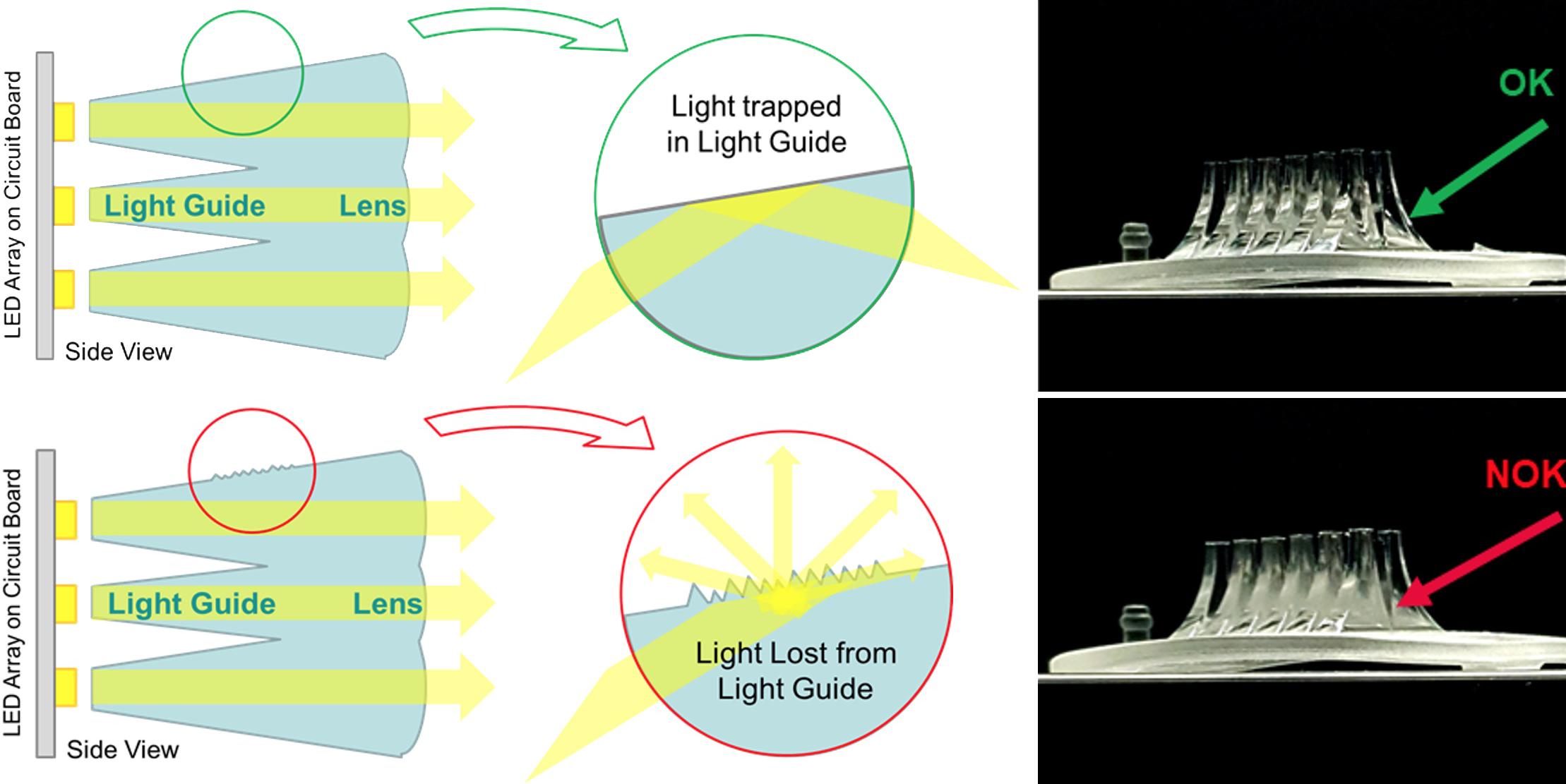
Figure 2: Effect of mold fouling is replicated on the optical part causing disruption of internal reflection conditions and subsequent loss of light from the lightguide (bottom illustration and picture) [7,8,10].
Figure 3: Total visible light transmission (L*) according to ASTM D1003 of SILASTIC™ MS-5002 and MS-1002 Moldable Silicone upon constant heat aging (150°C) measured on samples of 3 mm thickness.
Figure 4: Cure kinetics of SILASTIC™ MS-1002 and MS-5002 Moldable Silicones at 140°C and 170°C. MDR measurements made on Alfa Technologies Moving Die Rheometer W/S2K Premier model according to ASTM D5289.

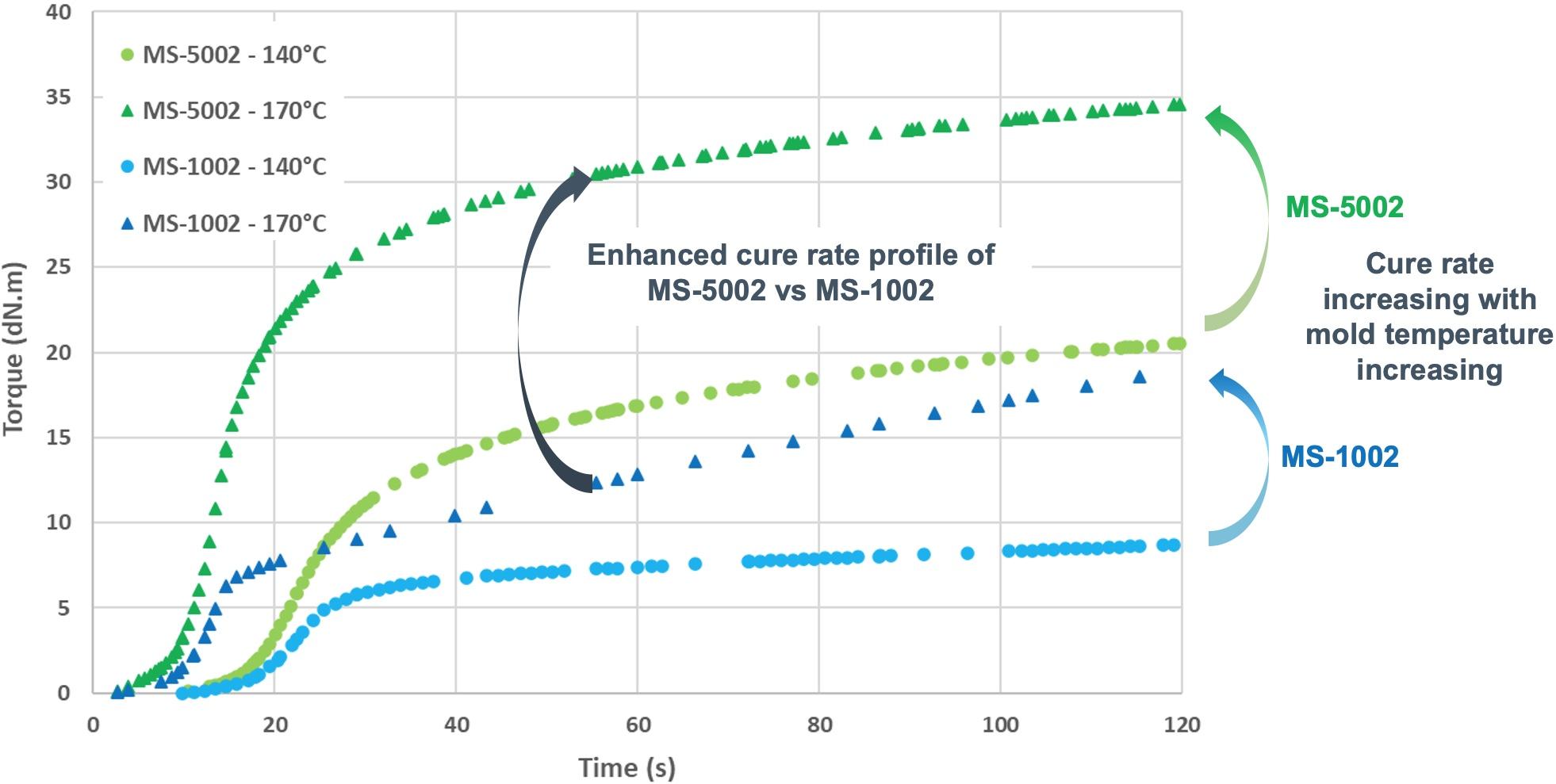
development. Overall, curing of LSR is achieved using vinyl end-blocked siloxane polymers and resins, reacting them with Si-H groups carried by functional siloxane oligomers [17]. This addition, or hydrosilylation, reaction occurs mainly on the terminal carbon (β–addition) and is catalyzed by Pt or Rh metal complexes, preferably organometallic compounds to enhance their compatibility with the medium, such as, Karstedt catalyst [18]. The art of LSR formulation consists in optimizing Pt catalyst and inhibitor concentrations, as well as the structure of the SiH siloxane crosslinker oligomer for controlling the rate of curing as function of temperature [19].
[Pt] / [inhibitor]
∼∼∼ OMe2Si-CH=CH2+H-Si≡ −→ ∼∼∼ OMe2Si-CH2-CH2-Si≡ (1)
where ≡ represents the remaining valences of the silicon atom.
Liquid Injection Molding and ELMET Mold Technology
The ELMET team have engineered a mold tool to produce ADB multiple lightguide silicone lenses with combined low beam and high beam functions as illustrated in Figure 5. This lens requires a very specific design with a 12 mm thick cross-section above the light guides in the light outcoupling area. The maximum cross-section with the light guide included, reaches 24.5 mm in its center, leading to challenging cycle times for mass production by liquid injection molding. The volume of the part is ≈ 35 cm3, corresponding to a weight of ≈ 37.5 g – given the specific gravity of 1.07 g/cc of the optical LSR.
The virtual representation of the low / highbeam combined primary ADB lens illustrated in Figure 5 shows the 16-lightguide function in two rows of eight and the thick optical outcoupling section. It illustrates the key design variables to take into consideration for optimizing design and production set-up. In respect of OEM customers’ confidentiality, this 16-lightguide design does not correspond to any real lens design on the market. However, the reduction of the number of pixels in ADB headlight systems is aligned to recent industry trends in automotive lighting. Which contributes to reducing the manufacturing cost of LED headlamp modules and expanding ADB headlight technology using silicone lightguide primary optics lenses across all car models, from B- to Esegment. Therefore, offering a safer nighttime driving experience to all end-users [4,9]. At a reasonable cost, lightguide designs with either one row of 17 segments, two rows of 19 segments or three rows of 20 segments, are already performing very similar to a multi-thousands of pixels system [20,21]. A present trend in ADB headlights, combining low / high beams is to design silicone lenses from 10- up to 24-lightguide.
To produce lenses as shown in Figure 5 with MS-5002, the molding set-up utilizes the current technological flagship in LSR dosing technology – ELMET SMARTmix TOP 7000 Pro (Figure 6) [22]. This new version represents the third generation of dosing systems used for SILASTIC™ Moldable Silicone materials since 2012, when Dow and ELMET started to collaborate on the qualification of dosing system for optical LSR. In terms of functionality, process reliability and user convenience the dosing system shows technical feasibility in dosing and processing liquid silicone rubber. Especially for processing high performance LSR-types, stable and precise mixing ratios are mandatory to ensure maximum process stability. Due to the volumetrically measured and balanced material flow, constant mixing ratio can be guaranteed easily, not only for the SMARTmix TOP 7000 Pro, but also for the previous generations TOP 5000 P and TOP 3000 S despite high differences of viscosity between parts A and B. Low viscosity of MS-5002, with respectively 62 800 mPa s for part A and 14 220 mPa s for part B, requires such a precise control of the 1:1 mixing ratio, with a maximum tolerance for deviation of 1%. Mixing efficiency is ensured by a 30-element static mixer split in 3 pieces assembled in series after the mixing block. In addition to excellent mixing, ELMET’s dosing systems are well known for ensuring almost waste-free series production. To increase cost efficiency and resource savings, the SMARTmix TOP 7000 Pro enables raw material utilization of up to 99.6%, making the system even more economic than the earlier systems.

Figure 5: Low/High beam combined 16-lightguide ADB lens design. Note the design is a one single piece optic and the color code for the light guide area (blue) versus the outcoupling lens area (green) and the non-optical areas (red) are only for illustration purposes. EoAT = End of Arm Tool.
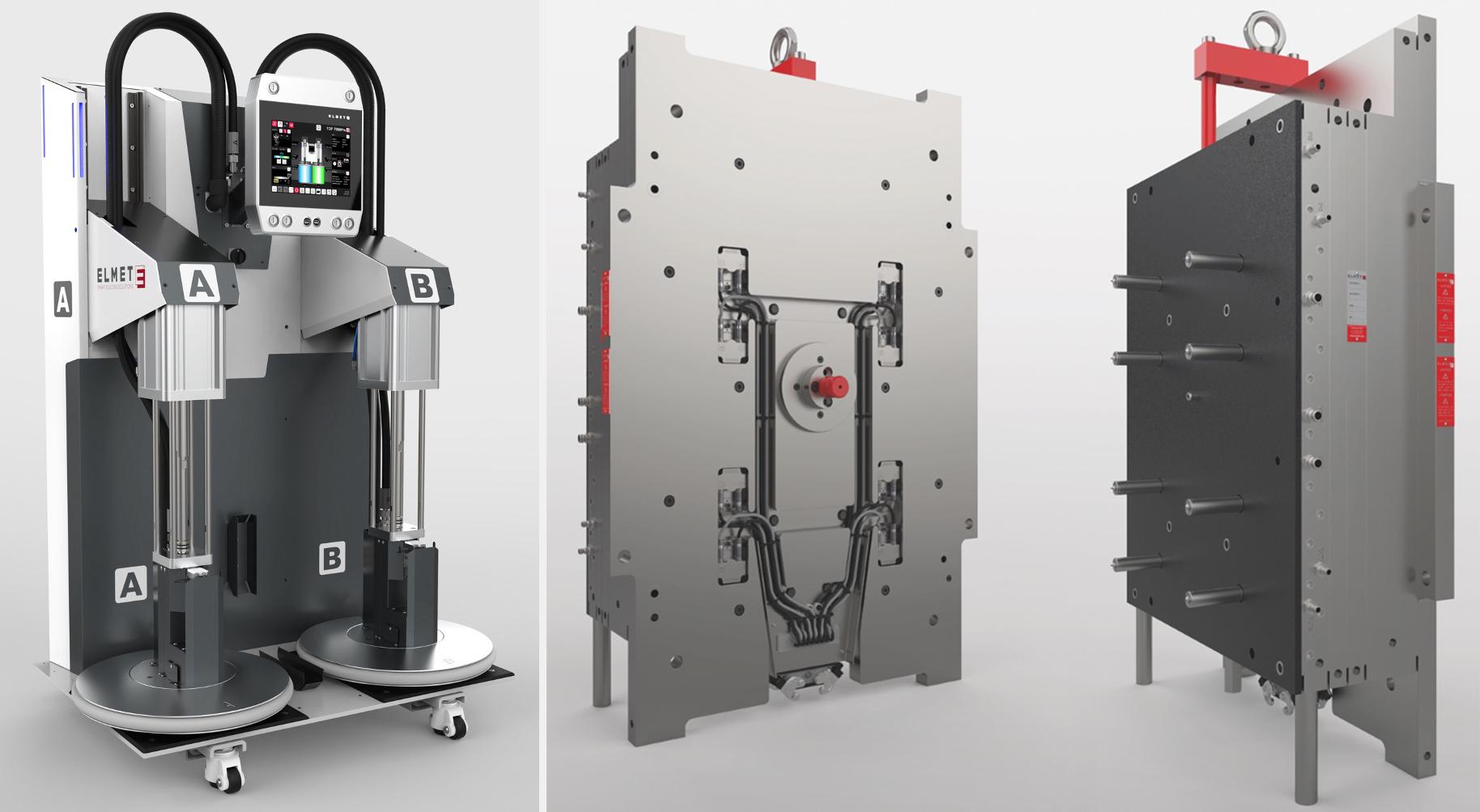
The pre-series mold used was designed with one unique cavity and manual lens demolding, and installed on an ENGEL Injection Molding Machine – Victory 330/120 Tech.
Manufacturing of the developmental ADB primary silicone optic took place at ELMET. The pre-series 1-cavity mold uses valve gate cold runner technology of ELMET’s SMARTshot series for perfect control of cavity filling without any sprues. ELMET cold decks are perfectly balanced and homogenously cooled to ensure correct viscosity for optimum flow and process stability when producing silicone ADB optics of the highest quality. Depending on customers’ requirements, needle movement can either be driven pneumatically (SMARTshot P) or electrically (SMARTshot E) without making compromises in precise positioning and constant flow rates. Due to the very low viscosity of optical grade LSR and the complex shapes of ADB silicone lenses, mold tooling design and fabrication can be very challenging. ELMET addressed such challenges with innovative high-precision mold fabrication technology. The mold inserts were machined and polished out of specific steel alloy and with appropriate thermal treatment, allowing for perfect transcription of the mold surface to the silicone elastomer surface during injection molding and curing of the parts, fulfilling optical industry standard requirements for both, the lightguide and the outcoupling sections of the lens.
Mechanism of Cure
For both MS-1002 and MS-5002 materials, the cure time was determined by consecutive cure time increases, in 5 seconds increments, to achieve complete solidification of the thickest cross-section in the lens. A visual determination of the cure time was achieved by cutting the silicone lenses immediately after manual demolding, in the appropriate cross-section (Figure 7). The cure time is determined as the necessary time to reach full cure of the bulk of the part. It appears very reproducible with a variation of +/- 2 sec as soon as the mold is at thermal equilibrium for molding. This thermal equilibrium considers a homogeneous heat distribution within the hot plates and mold inserts. The mixed parts A and B of the LSR is injected liquid and cold, regulated to 20 ◦C to maintain a constant viscosity during injection, and is responsible for thermal anisotropy when filling the mold insert cavity, cycle after cycle. Multiple molding cycles are therefore mandatory for each thermal condition tested, taking into consideration local cool down at the surface of the inserts, created by the action of the cold silicone flow from cycle to cycle. This method is repeated across the temperature range recommended by Dow, and at a selection of injection velocities between 5 cm3/s and 110 cm3/s. Due to time constraints, a complete DOE couldn’t be performed for both materials and some conditions combinations were skipped.
Influence of Mold Temperature
The design of the silicone lens, as illustrated in Figure 5, with a thick crosssection above the 16-lightguide section, directly impacts the cycle time; compared to first generation ADB lenses that were flatter and thinner. To achieve maximum production throughput and to benefit from the cure profile efficiency of both MS-1002 and MS-5002, the mold required specific engineering on the thermal transfer side. ELMET’s mold tool was designed to ensure curing of both MS-1002 and MS-5002 can take place in the widest possible process window, with mold mechanics operating in a range of temperature from 135 ◦C to 180 ◦C and offering the required robustness for demolding the lens and overflows. The mold temperature, besides its direct influence on lens shrinkage, was adjusted to reach the most efficient cycle time with optimal lens optical quality, without flow lines and other surface defects – as illustrated in Figure 8 - for MS-1002 and MS-5002 in the range of velocities from 20–110 cm3/s. This figure correlates the time needed to cure the material in the thickest cross-section (Figure 7) with the temperature of the tool, for two different injection velocities.
In the most common 130–160 ◦C temperature range for production of automotive ADB silicone primary lenses, both MS1002 and MS-5002 offer a cure time reduction of ≈ 10 sec/10 ◦C of mold temperature step increase. The cure temperature being the predominant factor to the hydrosylilation reaction. MS-5002 offers the benefits of its unique cure kinetics profile to reach an additional averaged gain of ≈ 10% of cure time reduction against MS1002 (at least at low injection velocity).
Above 160°C, and for this specific lens design, the predominant factor limiting the curing reaction, is associated to the low thermal conductivity of the materials, ≈ 0.2 W/mK [13]. The advantageous cure kinetic profile of MS-5002, at the high cure temperature of 180 ◦C, drops by 3–4 % versus MS-1002, depending on the selected injection velocity.

Figure 7: Definition of the cure time for both MS-1002 and MS-5002, across the cure temperature range and according to the injection velocity process window. Orange color indicates uncured material.

Influence of Injection Velocity
Based on ELMET’s expertise, the need for a very wide injection velocities window is critical for the mass production of such silicone lenses. The mold and cold runner valve gate technology were developed to allow flow profiles from 5–110 cm3/s. Like the adjustment of mold temperature, the injection velocity was increased to its optimum. This velocity is the third key contributor to the cycle time reduction, after selecting the appropriate SILASTIC™ Moldable Silicone material and the temperature of the mold at which it will be cured. With the objective of reaching the most efficient production throughput and the subsequent benefits on the cost of molding, MS5002 was selected over MS-1002, given its enhanced cure kinetics profile. The mechanical properties of MS-5002 make it fully compatible with the moderate degree of complexity of this lens design. While screening the relationship between injection velocity and the measured material pressure required by the machine to reach the flow (Figure 9), the expected linear correlation is observed across almost the entire velocity range. A small pressure drop created by temperature elevation, while marginal, is nevertheless explained by material viscosity decreasing, even though the material is metered at a constant temperature of 20 ◦C in the screw/barrel of the machine. Its injection through the gate point, at mold temperature in the 130–180 ◦C range, slightly elevates its temperature leading to the ≈ 8 bar pressure drop per 10 ◦C mold temperature increase. This effect can be considered as negligeable for LSR.
In addition to the cure time reduction, directly impacted by the material formulation and its associated cure kinetics profile, the influence of the injection velocity is illustrated in Figure 10 for MS-5002. Being in a laminar flow regime, thanks to small pipe dimensions in the molding tool, the temperature increases into the material results from friction, which depends on the velocity profile inside the pipes. Therefore, the self-elevation of material temperature, which contributes to accelerate cure kinetics, is the consequence of shear rate profile applied on the LSR during injection. This later is influenced by the specific molding tool design and SMARTshot E cold runner engineered geometry. Like the effect of the cure temperature, the impact of the injection velocity can be averaged at a value of 5% reduction per 20 cm3/s velocity increase. Exploring the molding process window boundaries by combining cure temperature and material velocity, plus the new MS-5002 material, for the particular design of Figure 5, demonstrated a total gain up to 50% in cure time reduction, from [130 ◦C @ 5 cm3/s] to [180 ◦C @ 110 cm3/s].
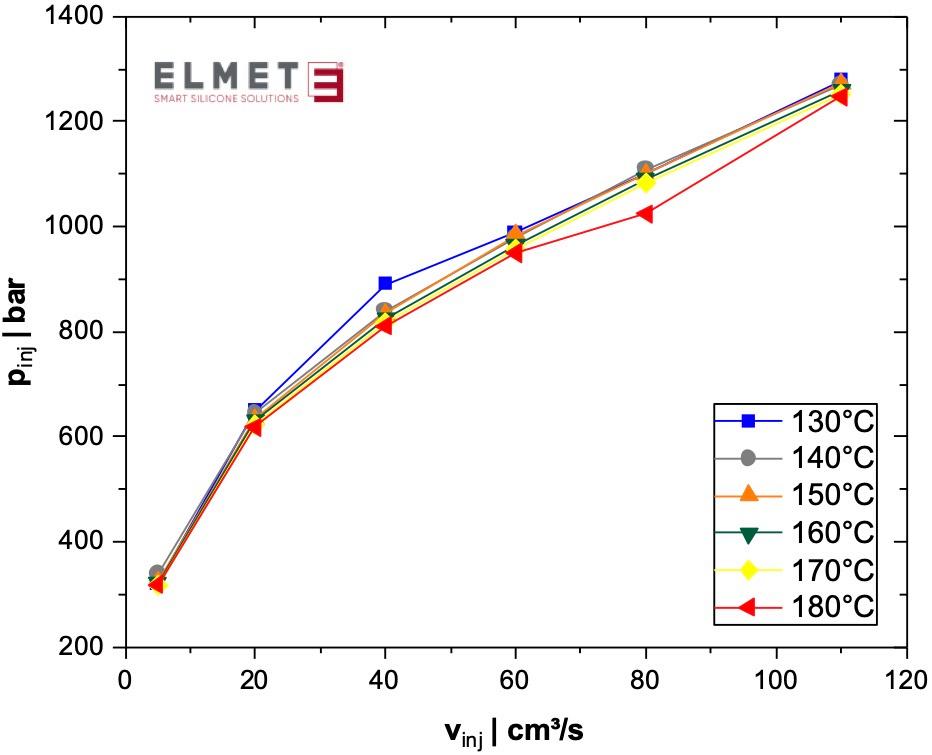
Figure 9: Pressure of injection of MS-5002 needed for reaching a given injection velocity.
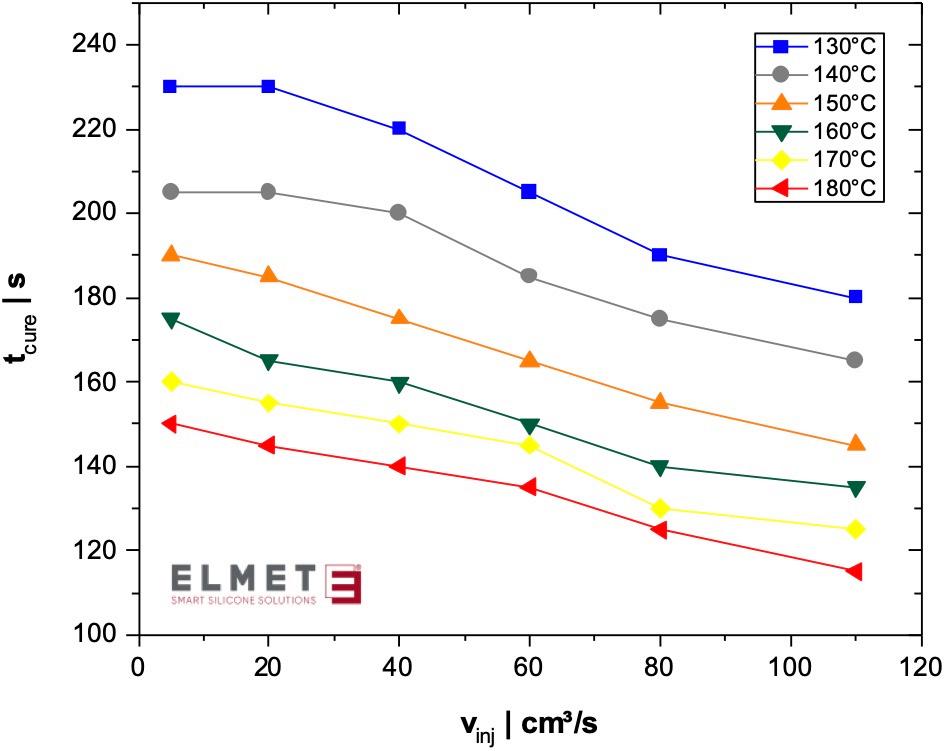
Conclusions
The effective collaborative approach of Dow and ELMET have proven to significantly advance the understanding of how optical silicone elastomer formulations and liquid injection molding processing are intimately related. From Dow’s side, both SILASTIC™ MS-1002 and MS-5002 Moldable Silicone are complementary optical LSR that are now offered to the market. Both materials are commercially available for mass production of silicone op-
tics. Their respective composition makes them perfectly interchangeable from dosing to injection unit. SILASTIC™ MS-5002, however, was recently designed and formulated to enhance the productivity of ADB silicone lenses for fabricators. With dual gains, (i) of reducing / suppressing mold fouling for several thousands of injection molding cycles – depending on complexity of the lens design and injection molding parameters (temperature, curing time), and (ii) in reducing curing time and therefore production throughput. Delivering 4-5x improvement in the number of injection molding cycles between mold cleaning while maintaining good optical quality, SILASTIC™ MS-5002 contributes directly to increase mass production efficiency by liquid injection molding. ELMET’s SMARTmix TOP 7000 Pro dosing system and SMARTshot E injection molding tool technology have been proven to offer an optimal turnkey injection molding setup when coupled with an ENGEL Victory 330/120 Tech injection molding press.
While SILASTIC™ MS-1002 Moldable Silicone is qualified as a global industry standard in lighting applications since the early 2010’s and has proved its performance since 2014 in ADB headlamps systems, next generation’s SILASTIC™ MS-5002 from Dow sets a new standard of performance. The mechanical properties, at demolding and after post-curing stages, enable design freedom for next generation of ADB silicone lenses combining various multiple-lightguide shapes and variable part thicknesses. The optical performance in long-term exposure to high heat (up to 150 ◦C) and high photon density meet Automotive Standards requirements worldwide and provide stable and high light transmittance over the lifetime of ADB headlamps. The robust shelf-life and stable pot-life, in addition to the optimized rheology and cure rate of SILASTIC™ MS-5002 Moldable Silicone, contribute to an ease of moldability and machinery maintenance, and offer a flexible production schedule from small, with frequent interruptions to full-scale 24/7 production schedules. ■
References
[1] SILASTIC™ MS-1002 Moldable Silicones A/B kit, https://www.dow.com/en- us/pdp.silastic- ms- 100 2-moldable-silicone-ab-kit.04093229z.html [2] M. Maier, J. Moisel, F. Herold, “Multibeam Headlights in the Mercedes-Benz CLS-Class”, ATZ World, vol.117, pp.4–9 (2015). https://doi.org/10.1007/s383 11-015-0156-0 [3] M. Maier, DAIMLER AG “MULTIBEAM LED Lights
Up the Night. The Future of Illumination Technology at Mercedes-Benz”, IQPC 15th Intelligent Automotive
Lighting conference, Dusseldorf, January 28 (2015). [4] American Automobile Association (AAA), 2019 https://www.aaa.com/AAA/common/AAR/files/Resea rchReportEuroSpecvsUSHeadlamps.pdf [5] E. Edmonds, “It’s Time to Bring U.S. Headlight
Standards Out of the Dark Ages”, AAA Newsroom,
April 16, 2019. https://newsroom.aaa.com/2019/04/r esearch-european-headlight-technology-us-low-bea m-safety/ [6] “SILASTIC™ moldable optical silicones help pave the way to a groundbreaking LED headlamp design from Hella KGaA Hueck & Co”, Dow case study form ref 11-3675-01C (2019). Available online from Hella
KGaA Hueck & Co. Develops LED Headlamp Design:
Case Study (https://www.dow.com/documents/en-u s/case- study/11/11- 36/11- 3675- 01- pave- the- way -groundbreaking-led-headlamp.pdf) [7] M. Beukema, F. de Buyl, V. Jansma, J. Steinbrecher,
K. Van Tiggelen, “Solutions and concepts for the evolving automotive lighting industry” accessible on demand from SILASTIC™ MS-5002 Moldable Silicone (https://www.dow.com/en- us/pdp.silastic- ms- 500 2-moldable-silicone.504791z.html?productCatalogF lag=1#overview). [8] M. Bradford and F. de Buyl, “Solutions for the evolving automotive lighting industry”, IQPC 21th Intelligent Lighting conference, online webinar, October 5 (2021). [9] S. Klapper (IHS Markit), “Shaping the Future of
Automotive Lighting: A global Outlook”, IQPC 20th
Intelligent Automotive Lighting conference, Cologne,
February 17-20 (2020). [10] J. Steinbrecher, “Innovation in Liquid Silicone
Rubber: Using sound material science to solve performance and manufacturing challenges”, LSR 2021 (14 Sept.) Chicago. [11] F. de Buyl, et al. “Dow Corning Moldable Silicone
Leading Innovation in LED Light Fixtures”, Journal of The Society of Silicon Chemistry Japan, No.31; pp.23-38 (2014). [12] “Moldable Optical Silicone Elastomers Spark creativity in LED Lighting”, Laser Focus World, pp. 41-45 (October 2019), published online on https: //www.laserfocusworld.com/optics/article/14040094/ moldable-optical-silicone-elastomers-spark-creativit y-in-led-lighting [13] F. de Buyl and S. Yoshida, “Reliability of Organic
Compounds in Microelectronics and Optoelectronics – chapter 1: Degradation Mechanisms of Silicones”,
W.D. van Driel and M. Yazdan Mehr editors, Spinger publisher, ISBN 978-3-030-81575-2, https://doi.org/ 10.1007/978-3-030-81576-9 (2022). [14] M. Yazdan Mehr, W.D. van Driel, F. de Buyl, G.Q.
Zhang, “Study on the Degradation of Optical Silicone
Exposed to Harsh Environments”, Materials, vol. 11, pp. 1305 (2018). [15] “Dow and Schréder team up for Eastern Europe’s first LED-illuminated sports stadium”, Dow Form N° 11-3890-01A (2019), available on https://www.dow. com/documents/en-us/case-study/11/11-38/11-389 0-01-sports-stadium-illuminate-schreder.pdf [16] “Carclo S1 Optic’s light engine designed with
SILASTIC™ MS-4002 Moldable Silicone”, Dow Form
N° 11-4233-01-0821 AMPM (2021), available on https://www.dow.com/documents/en-us/case-study /11/11- 42/11- 4233- 01- carclo- optic- engine- silasti c-ms-4002-moldable-silicone.pdf [17] F.O. Stark , J.R. Falender, A.P. Wright. “Silicones.
Comprehensive Organometallic Chemistry”. G.
Wilkinson, F.G.A. Stone, E.W. Abel editors. Pergamon
Press. 2, 305-363 (1982). [18] Stein J, Lewis L N, Gao Y, Scott R A., “In Situ Determination of the Active Catalyst in Hydrosilylation
Reactions Using Highly Reactive Pt(0) Catalyst Precursors”, J. Am. Chem. Soc., vol.121, pp3693-3703 (1999) [19] P. Beyer, N. Gerard, H.P. Wolf, “Low temperature cure of liquid silicone rubber”, RFP International, vol. 14, issue 3, pp. 168-172 (2019). [20] D. Hynar (Varroc), “Overview of current ADB solutions low to high cost”, IQPC 19th Intelligent Automotive Lighting conference, Mainz, February 20-22 (2019). [21] P. Ferbas, J. Martoch, S. Büttgen, H. Groner (Varroc Lighting System), “Opti ADB and Study on
Low Number of Segments” IQPC 20th Intelligent
Automotive Lighting conference, Cologne, February 17-20 (2020). [22] Elmet SMARTmix TOP 7000 Pro and SMARTshot
E, accessible on https://www.elmet.com/EN/downloa ds
Martijn BEUKEMA mabeukema@dow.com, François DE BUYL francois.debuyl@dow.com, Hannes RIEGER h.rieger@elmet.com, Jake STEINBRECHER jacob.steinbrecher@dow.com, Kevin V. TIGGELEN kevin.vantiggelen@dow.com. (top to bottom)
